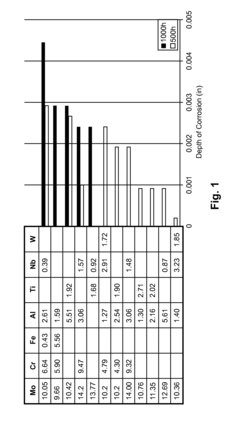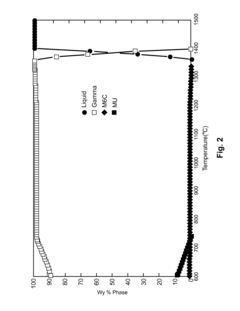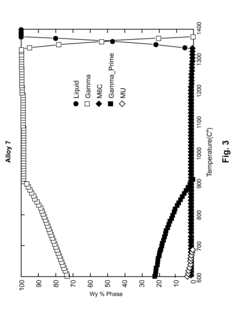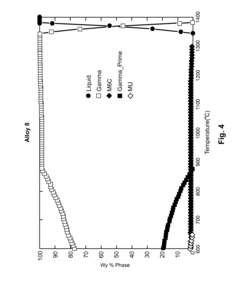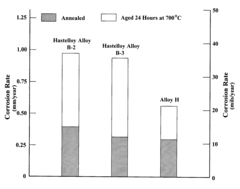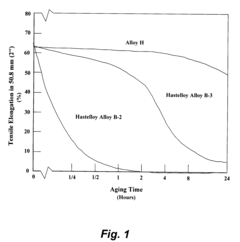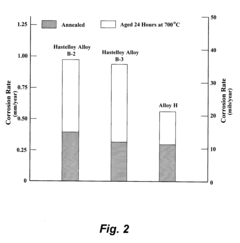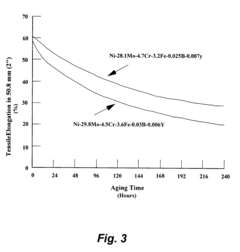Hastelloy Alloy Systems for Achieving Industrial Growth
JUL 10, 20259 MIN READ
Generate Your Research Report Instantly with AI Agent
Patsnap Eureka helps you evaluate technical feasibility & market potential.
Hastelloy Alloy Evolution and Objectives
Hastelloy alloys have undergone significant evolution since their inception in the early 20th century. Initially developed by Haynes International, these nickel-chromium-based superalloys have continuously adapted to meet the growing demands of various industries. The primary objective behind the development of Hastelloy alloys has been to create materials capable of withstanding extreme environments, particularly those involving high temperatures and corrosive substances.
The evolution of Hastelloy alloys can be traced through several key milestones. Early versions focused on improving corrosion resistance in specific chemical environments. As industrial applications expanded, subsequent generations of Hastelloy alloys were engineered to offer enhanced mechanical properties at elevated temperatures, making them suitable for use in gas turbines and other high-temperature applications.
Recent advancements in Hastelloy alloy systems have been driven by the need for materials that can perform in increasingly demanding conditions. This includes environments with complex combinations of high temperatures, pressures, and corrosive media. The current objectives in Hastelloy alloy research are multifaceted, aiming to push the boundaries of material performance even further.
One primary goal is to develop alloys with improved high-temperature strength and creep resistance. This is crucial for applications in advanced power generation systems and aerospace components, where materials must maintain their integrity under extreme thermal loads for extended periods. Another objective is to enhance the alloys' resistance to a broader spectrum of corrosive environments, particularly in the chemical processing and oil and gas industries.
Researchers are also focusing on improving the manufacturability of Hastelloy alloys. This includes developing compositions that are more amenable to advanced manufacturing techniques such as additive manufacturing, which could revolutionize the production of complex components. Additionally, there is a growing emphasis on creating alloys with improved weldability and formability, facilitating easier fabrication and assembly of large-scale industrial equipment.
The pursuit of these objectives is closely tied to the broader goal of achieving industrial growth. By developing Hastelloy alloys with superior properties, industries can design more efficient and durable equipment, leading to increased productivity and reduced maintenance costs. Furthermore, the ability to operate in more extreme conditions opens up new possibilities for industrial processes and energy production, potentially driving innovation across multiple sectors.
The evolution of Hastelloy alloys can be traced through several key milestones. Early versions focused on improving corrosion resistance in specific chemical environments. As industrial applications expanded, subsequent generations of Hastelloy alloys were engineered to offer enhanced mechanical properties at elevated temperatures, making them suitable for use in gas turbines and other high-temperature applications.
Recent advancements in Hastelloy alloy systems have been driven by the need for materials that can perform in increasingly demanding conditions. This includes environments with complex combinations of high temperatures, pressures, and corrosive media. The current objectives in Hastelloy alloy research are multifaceted, aiming to push the boundaries of material performance even further.
One primary goal is to develop alloys with improved high-temperature strength and creep resistance. This is crucial for applications in advanced power generation systems and aerospace components, where materials must maintain their integrity under extreme thermal loads for extended periods. Another objective is to enhance the alloys' resistance to a broader spectrum of corrosive environments, particularly in the chemical processing and oil and gas industries.
Researchers are also focusing on improving the manufacturability of Hastelloy alloys. This includes developing compositions that are more amenable to advanced manufacturing techniques such as additive manufacturing, which could revolutionize the production of complex components. Additionally, there is a growing emphasis on creating alloys with improved weldability and formability, facilitating easier fabrication and assembly of large-scale industrial equipment.
The pursuit of these objectives is closely tied to the broader goal of achieving industrial growth. By developing Hastelloy alloys with superior properties, industries can design more efficient and durable equipment, leading to increased productivity and reduced maintenance costs. Furthermore, the ability to operate in more extreme conditions opens up new possibilities for industrial processes and energy production, potentially driving innovation across multiple sectors.
Industrial Demand Analysis for Hastelloy Alloys
The demand for Hastelloy alloys in industrial applications has been steadily increasing due to their exceptional corrosion resistance and high-temperature strength. These nickel-chromium-based superalloys are crucial in various sectors, including chemical processing, oil and gas, aerospace, and nuclear power generation. The global market for Hastelloy alloys is driven by the growing need for materials that can withstand extreme environments and maintain structural integrity under harsh conditions.
In the chemical processing industry, Hastelloy alloys are extensively used in reactors, heat exchangers, and piping systems. The demand is particularly strong in the production of specialty chemicals and pharmaceuticals, where corrosive materials and high temperatures are common. The oil and gas sector also relies heavily on Hastelloy alloys for downhole tools, wellhead components, and offshore platforms, as these materials can resist the corrosive effects of hydrogen sulfide and chlorides found in oil and gas extraction processes.
The aerospace industry is another significant consumer of Hastelloy alloys, utilizing them in jet engine components, exhaust systems, and structural parts. As the aerospace sector continues to push the boundaries of performance and efficiency, the demand for high-temperature resistant materials like Hastelloy is expected to grow. Similarly, the nuclear power industry depends on these alloys for reactor components and waste processing equipment due to their resistance to radiation-induced corrosion.
Emerging technologies and industries are also contributing to the increased demand for Hastelloy alloys. For instance, the rapid development of hydrogen fuel cell technology has created new applications for these materials in fuel cell components and hydrogen production equipment. Additionally, the growing focus on renewable energy sources has led to increased use of Hastelloy alloys in geothermal power plants and concentrated solar power systems.
The market for Hastelloy alloys is influenced by global economic trends and industrial growth patterns. Developing economies, particularly in Asia-Pacific and the Middle East, are experiencing rapid industrialization, which is driving the demand for high-performance materials. These regions are investing heavily in chemical manufacturing, oil refining, and power generation infrastructure, all of which require corrosion-resistant alloys like Hastelloy.
Environmental regulations and safety standards are also playing a crucial role in shaping the demand for Hastelloy alloys. As industries face stricter requirements for emissions control and process safety, there is a growing need for materials that can withstand more aggressive operating conditions while maintaining long-term reliability. This trend is particularly evident in the chemical and petrochemical sectors, where Hastelloy alloys are increasingly preferred over traditional materials for their superior performance in corrosive environments.
In the chemical processing industry, Hastelloy alloys are extensively used in reactors, heat exchangers, and piping systems. The demand is particularly strong in the production of specialty chemicals and pharmaceuticals, where corrosive materials and high temperatures are common. The oil and gas sector also relies heavily on Hastelloy alloys for downhole tools, wellhead components, and offshore platforms, as these materials can resist the corrosive effects of hydrogen sulfide and chlorides found in oil and gas extraction processes.
The aerospace industry is another significant consumer of Hastelloy alloys, utilizing them in jet engine components, exhaust systems, and structural parts. As the aerospace sector continues to push the boundaries of performance and efficiency, the demand for high-temperature resistant materials like Hastelloy is expected to grow. Similarly, the nuclear power industry depends on these alloys for reactor components and waste processing equipment due to their resistance to radiation-induced corrosion.
Emerging technologies and industries are also contributing to the increased demand for Hastelloy alloys. For instance, the rapid development of hydrogen fuel cell technology has created new applications for these materials in fuel cell components and hydrogen production equipment. Additionally, the growing focus on renewable energy sources has led to increased use of Hastelloy alloys in geothermal power plants and concentrated solar power systems.
The market for Hastelloy alloys is influenced by global economic trends and industrial growth patterns. Developing economies, particularly in Asia-Pacific and the Middle East, are experiencing rapid industrialization, which is driving the demand for high-performance materials. These regions are investing heavily in chemical manufacturing, oil refining, and power generation infrastructure, all of which require corrosion-resistant alloys like Hastelloy.
Environmental regulations and safety standards are also playing a crucial role in shaping the demand for Hastelloy alloys. As industries face stricter requirements for emissions control and process safety, there is a growing need for materials that can withstand more aggressive operating conditions while maintaining long-term reliability. This trend is particularly evident in the chemical and petrochemical sectors, where Hastelloy alloys are increasingly preferred over traditional materials for their superior performance in corrosive environments.
Hastelloy Development Challenges
The development of Hastelloy alloy systems faces several significant challenges that hinder its industrial growth and widespread adoption. One of the primary obstacles is the high cost associated with raw materials and production processes. The complex composition of Hastelloy alloys, which typically include nickel, chromium, molybdenum, and other expensive elements, contributes to elevated manufacturing expenses. This cost factor limits the alloy's application in price-sensitive industries and makes it challenging to compete with more economical alternatives.
Another major hurdle is the difficulty in achieving consistent material properties across different production batches. The intricate microstructure of Hastelloy alloys is highly sensitive to slight variations in composition and processing parameters. This sensitivity can lead to inconsistencies in mechanical properties, corrosion resistance, and overall performance, potentially compromising the reliability of components made from these alloys. Manufacturers must invest heavily in quality control measures and advanced processing techniques to maintain the desired material characteristics.
The limited formability and machinability of Hastelloy alloys present additional challenges in manufacturing processes. These alloys often exhibit high work hardening rates and low thermal conductivity, making them difficult to shape and machine using conventional methods. This limitation necessitates specialized equipment and expertise, further increasing production costs and limiting the number of manufacturers capable of working with these materials effectively.
Welding and joining Hastelloy alloys also pose significant technical challenges. The high nickel content and complex alloying elements can lead to issues such as hot cracking, segregation, and the formation of detrimental intermetallic phases in the heat-affected zone. These welding-related problems can compromise the integrity of the joined components and reduce their overall performance, particularly in critical applications where joint reliability is paramount.
Furthermore, the development of new Hastelloy compositions tailored for specific industrial applications is a time-consuming and resource-intensive process. The complex interactions between alloying elements and their effects on material properties require extensive research, testing, and validation. This prolonged development cycle can hinder the rapid adaptation of Hastelloy alloys to emerging industrial needs and technological advancements.
Lastly, the limited availability of comprehensive material data and design guidelines for Hastelloy alloys poses challenges for engineers and designers. The lack of standardized information on long-term performance, fatigue behavior, and creep resistance under various operating conditions can lead to conservative designs or hesitation in adopting these alloys for new applications. Overcoming this knowledge gap requires substantial investment in long-term testing and data collection efforts across diverse industrial sectors.
Another major hurdle is the difficulty in achieving consistent material properties across different production batches. The intricate microstructure of Hastelloy alloys is highly sensitive to slight variations in composition and processing parameters. This sensitivity can lead to inconsistencies in mechanical properties, corrosion resistance, and overall performance, potentially compromising the reliability of components made from these alloys. Manufacturers must invest heavily in quality control measures and advanced processing techniques to maintain the desired material characteristics.
The limited formability and machinability of Hastelloy alloys present additional challenges in manufacturing processes. These alloys often exhibit high work hardening rates and low thermal conductivity, making them difficult to shape and machine using conventional methods. This limitation necessitates specialized equipment and expertise, further increasing production costs and limiting the number of manufacturers capable of working with these materials effectively.
Welding and joining Hastelloy alloys also pose significant technical challenges. The high nickel content and complex alloying elements can lead to issues such as hot cracking, segregation, and the formation of detrimental intermetallic phases in the heat-affected zone. These welding-related problems can compromise the integrity of the joined components and reduce their overall performance, particularly in critical applications where joint reliability is paramount.
Furthermore, the development of new Hastelloy compositions tailored for specific industrial applications is a time-consuming and resource-intensive process. The complex interactions between alloying elements and their effects on material properties require extensive research, testing, and validation. This prolonged development cycle can hinder the rapid adaptation of Hastelloy alloys to emerging industrial needs and technological advancements.
Lastly, the limited availability of comprehensive material data and design guidelines for Hastelloy alloys poses challenges for engineers and designers. The lack of standardized information on long-term performance, fatigue behavior, and creep resistance under various operating conditions can lead to conservative designs or hesitation in adopting these alloys for new applications. Overcoming this knowledge gap requires substantial investment in long-term testing and data collection efforts across diverse industrial sectors.
Current Hastelloy Alloy Solutions
01 Composition and manufacturing of Hastelloy alloys
Hastelloy alloys are specialized nickel-based superalloys known for their excellent corrosion resistance and high-temperature strength. The composition typically includes varying amounts of chromium, molybdenum, and other elements to enhance specific properties. Manufacturing processes may involve precise control of alloying elements, heat treatments, and forming techniques to achieve desired characteristics.- Composition and manufacturing of Hastelloy alloys: Hastelloy alloys are specialized nickel-based superalloys known for their excellent corrosion resistance and high-temperature strength. The composition typically includes varying amounts of chromium, molybdenum, and other elements to enhance specific properties. Manufacturing processes may involve precise control of alloying elements, heat treatments, and forming techniques to achieve desired characteristics.
- Applications of Hastelloy alloys in extreme environments: Hastelloy alloys are widely used in industries requiring materials that can withstand extreme conditions. These applications include chemical processing equipment, nuclear reactors, aerospace components, and oil and gas exploration. The alloys' resistance to various forms of corrosion, oxidation, and high-temperature degradation makes them suitable for these demanding environments.
- Surface treatment and coating techniques for Hastelloy alloys: Various surface treatment and coating methods are employed to further enhance the properties of Hastelloy alloys. These techniques may include thermal spraying, laser cladding, or the application of specialized coatings to improve wear resistance, reduce friction, or provide additional protection against specific types of corrosion or environmental factors.
- Welding and joining methods for Hastelloy alloys: Joining Hastelloy alloys requires specialized welding techniques due to their unique composition and properties. Methods such as gas tungsten arc welding (GTAW), electron beam welding, and laser welding are often employed. Proper selection of filler materials, pre- and post-weld heat treatments, and control of welding parameters are crucial to maintain the alloy's integrity and performance in the welded region.
- Development of new Hastelloy alloy variants: Ongoing research focuses on developing new Hastelloy alloy compositions to meet evolving industrial needs. These efforts aim to improve specific properties such as creep resistance, fatigue strength, or resistance to particular corrosive environments. Advanced manufacturing techniques, including powder metallurgy and additive manufacturing, are being explored to create alloys with tailored microstructures and enhanced performance characteristics.
02 Applications of Hastelloy alloys in extreme environments
Hastelloy alloys find extensive use in industries requiring materials that can withstand extreme conditions. These applications include chemical processing equipment, nuclear reactors, aerospace components, and oil and gas exploration tools. The alloys' resistance to corrosion, oxidation, and high temperatures makes them suitable for these demanding environments.Expand Specific Solutions03 Surface treatment and coating techniques for Hastelloy alloys
Various surface treatment and coating methods are employed to further enhance the properties of Hastelloy alloys. These techniques may include thermal spraying, laser cladding, or the application of specialized coatings to improve wear resistance, corrosion protection, or thermal barrier properties. Such treatments can extend the lifespan and performance of Hastelloy components in specific applications.Expand Specific Solutions04 Welding and joining methods for Hastelloy alloys
Joining Hastelloy alloys requires specialized welding techniques due to their unique composition and properties. Methods such as gas tungsten arc welding (GTAW), electron beam welding, and laser welding are commonly used. Proper selection of filler materials, pre-heating, and post-weld heat treatments are crucial to maintain the alloy's integrity and prevent issues like hot cracking or loss of corrosion resistance in the welded areas.Expand Specific Solutions05 Development of new Hastelloy alloy variants
Ongoing research focuses on developing new Hastelloy alloy variants with improved properties or tailored characteristics for specific applications. This may involve adjusting the alloy composition, exploring novel processing techniques, or incorporating advanced manufacturing methods like additive manufacturing. The goal is to create alloys with enhanced performance in areas such as creep resistance, fatigue strength, or resistance to specific corrosive environments.Expand Specific Solutions
Key Hastelloy Manufacturers and Competitors
The research on Hastelloy Alloy Systems for industrial growth is in a mature stage, with a competitive landscape shaped by established players and academic institutions. The market size is substantial, driven by the alloy's widespread applications in aerospace, chemical processing, and energy sectors. Technologically, the field is advanced, with companies like NIPPON STEEL, Mitsubishi Materials, and Umicore leading innovation. Universities such as City University of Hong Kong and King Fahd University of Petroleum & Minerals contribute significantly to R&D. The industry is characterized by ongoing efforts to enhance alloy properties and develop new applications, indicating a dynamic and evolving market with potential for further growth and technological advancements.
Umicore SA
Technical Solution: Umicore SA has been conducting extensive research on Hastelloy alloy systems, focusing on sustainable production methods and recycling technologies. Their approach emphasizes the development of resource-efficient processes for manufacturing high-performance nickel-based superalloys. Umicore has invested in advanced recycling technologies to recover and reuse critical elements from end-of-life Hastelloy components, reducing the environmental impact of alloy production[10]. The company has also explored novel alloying techniques, such as mechanical alloying and rapid solidification, to create Hastelloy variants with improved corrosion resistance and mechanical properties[11]. Umicore's research includes the development of nanostructured Hastelloy alloys with enhanced strength and ductility, achieved through careful control of grain size and precipitate distribution[12]. Additionally, they have made progress in developing environmentally friendly surface treatment processes that improve the durability of Hastelloy alloys without the use of harmful chemicals.
Strengths: Strong focus on sustainability, expertise in materials recycling, and advanced processing technologies. Weaknesses: Potential challenges in scaling up novel production methods and balancing performance with environmental considerations.
NIPPON STEEL CORP.
Technical Solution: NIPPON STEEL CORP. has made significant advancements in Hastelloy alloy systems research, focusing on improving corrosion resistance and mechanical properties. Their approach involves fine-tuning the composition of nickel-based superalloys, particularly by optimizing the content of chromium, molybdenum, and tungsten. The company has developed a proprietary heat treatment process that enhances the microstructure of Hastelloy alloys, resulting in improved creep resistance at high temperatures[1]. Additionally, NIPPON STEEL has implemented advanced manufacturing techniques, such as powder metallurgy and additive manufacturing, to produce Hastelloy components with complex geometries and superior performance characteristics[2]. Their research also extends to surface modification techniques, including the development of specialized coatings that further enhance the alloy's resistance to aggressive chemical environments[3].
Strengths: Extensive experience in metallurgy, strong R&D capabilities, and integrated production facilities. Weaknesses: High production costs and potential limitations in scaling up new alloy compositions for mass production.
Innovative Hastelloy Compositions
High Strength Alloys for High Temperature Service in Liquid-Salt Cooled Energy Systems
PatentActiveUS20140271338A1
Innovation
- Development of a cobalt-free alloy with specific weight percent compositions, including Cr, Al, Fe, Mn, Mo, Ta, Ti, Nb, W, C, B, and N, that achieves high yield and tensile strengths, creep rupture life, and resistance to liquid fluoride salt corrosion through γ′ microstructural components and solid solution strengthening, while avoiding brittle intermetallic phases.
Corrosion-resistant nickel-base alloy
PatentInactiveUS20090004043A1
Innovation
- A corrosion-resistant nickel-base alloy with balanced proportions of nickel, molybdenum, chromium, and iron, along with effective amounts of yttrium and boron, is developed to stabilize grain boundaries and maintain ductility, with optional minor additives like silicon, manganese, and aluminum, optimizing the molybdenum, chromium, and iron ratio to extend the incubation period for ordering reactions.
Environmental Impact of Hastelloy Production
The production of Hastelloy alloys, while essential for various industrial applications, carries significant environmental implications that warrant careful consideration. The manufacturing process of these high-performance nickel-chromium-based superalloys involves energy-intensive operations and the use of potentially hazardous materials, which can lead to environmental concerns if not properly managed.
One of the primary environmental impacts of Hastelloy production is the substantial energy consumption required for melting and processing the alloy components. The high melting points of nickel and chromium necessitate the use of electric arc furnaces or vacuum induction melting, both of which demand considerable electrical power. This energy-intensive process contributes to increased carbon emissions, particularly in regions where electricity generation relies heavily on fossil fuels.
The extraction and refining of raw materials for Hastelloy production, including nickel, chromium, and molybdenum, also pose environmental challenges. Mining operations can lead to habitat destruction, soil erosion, and water pollution if not conducted responsibly. Additionally, the refining processes for these metals often involve chemical treatments that may generate hazardous waste and emissions if not properly controlled.
During the manufacturing of Hastelloy alloys, various chemical processes are employed, including pickling and passivation treatments. These processes utilize acids and other chemicals that, if not managed correctly, can result in the release of harmful substances into the environment. Proper waste management and treatment systems are crucial to mitigate the risk of soil and water contamination.
The production of Hastelloy generates metal dust and fumes, which can be hazardous to both human health and the environment if not adequately controlled. Advanced filtration systems and proper ventilation are essential to minimize the release of these particulates into the atmosphere and protect workers and surrounding communities.
However, it is important to note that the environmental impact of Hastelloy production should be balanced against the alloy's beneficial applications in industries such as chemical processing, pollution control, and renewable energy. Hastelloy's corrosion resistance and durability often lead to longer-lasting equipment and reduced material consumption over time, potentially offsetting some of the environmental costs associated with its production.
To address these environmental concerns, many Hastelloy manufacturers are implementing sustainable practices and technologies. These include investing in more energy-efficient melting processes, implementing closed-loop recycling systems for production waste, and exploring alternative raw material sources. Additionally, advancements in alloy design are focusing on reducing the content of scarce or environmentally problematic elements without compromising performance.
One of the primary environmental impacts of Hastelloy production is the substantial energy consumption required for melting and processing the alloy components. The high melting points of nickel and chromium necessitate the use of electric arc furnaces or vacuum induction melting, both of which demand considerable electrical power. This energy-intensive process contributes to increased carbon emissions, particularly in regions where electricity generation relies heavily on fossil fuels.
The extraction and refining of raw materials for Hastelloy production, including nickel, chromium, and molybdenum, also pose environmental challenges. Mining operations can lead to habitat destruction, soil erosion, and water pollution if not conducted responsibly. Additionally, the refining processes for these metals often involve chemical treatments that may generate hazardous waste and emissions if not properly controlled.
During the manufacturing of Hastelloy alloys, various chemical processes are employed, including pickling and passivation treatments. These processes utilize acids and other chemicals that, if not managed correctly, can result in the release of harmful substances into the environment. Proper waste management and treatment systems are crucial to mitigate the risk of soil and water contamination.
The production of Hastelloy generates metal dust and fumes, which can be hazardous to both human health and the environment if not adequately controlled. Advanced filtration systems and proper ventilation are essential to minimize the release of these particulates into the atmosphere and protect workers and surrounding communities.
However, it is important to note that the environmental impact of Hastelloy production should be balanced against the alloy's beneficial applications in industries such as chemical processing, pollution control, and renewable energy. Hastelloy's corrosion resistance and durability often lead to longer-lasting equipment and reduced material consumption over time, potentially offsetting some of the environmental costs associated with its production.
To address these environmental concerns, many Hastelloy manufacturers are implementing sustainable practices and technologies. These include investing in more energy-efficient melting processes, implementing closed-loop recycling systems for production waste, and exploring alternative raw material sources. Additionally, advancements in alloy design are focusing on reducing the content of scarce or environmentally problematic elements without compromising performance.
Hastelloy Standards and Certifications
Hastelloy alloys are subject to rigorous standards and certifications to ensure their quality, performance, and reliability in various industrial applications. The American Society for Testing and Materials (ASTM) has established several standards specifically for Hastelloy alloys, including ASTM B575 for plate, sheet, and strip, and ASTM B622 for seamless pipe and tube. These standards define the chemical composition, mechanical properties, and testing requirements for different grades of Hastelloy alloys.
The American Society of Mechanical Engineers (ASME) has also incorporated Hastelloy alloys into its Boiler and Pressure Vessel Code, recognizing their suitability for high-temperature and corrosive environments. ASME Section II, Part B covers the material specifications for Hastelloy alloys used in pressure vessel applications, while Section VIII provides guidelines for their use in the construction of pressure vessels.
In the aerospace industry, Hastelloy alloys are certified under various specifications, such as AMS 5390 for Hastelloy X and AMS 5608 for Hastelloy C-276. These aerospace material specifications ensure that the alloys meet the stringent requirements for use in aircraft engines and other critical components.
The nuclear industry has its own set of standards for Hastelloy alloys, including those set by the American Nuclear Society (ANS) and the Nuclear Regulatory Commission (NRC). These standards address the use of Hastelloy alloys in nuclear reactor components and fuel processing equipment, focusing on their corrosion resistance and mechanical stability under extreme conditions.
International standards organizations, such as the International Organization for Standardization (ISO), have also developed standards for nickel-based alloys, including Hastelloy. ISO 6207 covers the chemical composition and form of wrought corrosion-resistant nickel alloy plate, sheet, and strip, which includes several Hastelloy grades.
Certification processes for Hastelloy alloys often involve third-party testing and verification to ensure compliance with these standards. Organizations like Lloyd's Register, DNV GL, and the American Bureau of Shipping provide certification services for Hastelloy products used in marine and offshore applications, validating their suitability for use in harsh maritime environments.
To maintain quality control and traceability, manufacturers of Hastelloy alloys implement comprehensive quality management systems, often certified to ISO 9001 standards. These systems ensure consistent production processes, material properties, and documentation throughout the supply chain.
As the industrial applications for Hastelloy alloys continue to expand, new standards and certifications are being developed to address emerging needs. For instance, the growing use of Hastelloy alloys in additive manufacturing has led to the development of new standards for powder metallurgy and 3D printing processes, ensuring that additively manufactured Hastelloy components meet the same rigorous requirements as traditionally manufactured parts.
The American Society of Mechanical Engineers (ASME) has also incorporated Hastelloy alloys into its Boiler and Pressure Vessel Code, recognizing their suitability for high-temperature and corrosive environments. ASME Section II, Part B covers the material specifications for Hastelloy alloys used in pressure vessel applications, while Section VIII provides guidelines for their use in the construction of pressure vessels.
In the aerospace industry, Hastelloy alloys are certified under various specifications, such as AMS 5390 for Hastelloy X and AMS 5608 for Hastelloy C-276. These aerospace material specifications ensure that the alloys meet the stringent requirements for use in aircraft engines and other critical components.
The nuclear industry has its own set of standards for Hastelloy alloys, including those set by the American Nuclear Society (ANS) and the Nuclear Regulatory Commission (NRC). These standards address the use of Hastelloy alloys in nuclear reactor components and fuel processing equipment, focusing on their corrosion resistance and mechanical stability under extreme conditions.
International standards organizations, such as the International Organization for Standardization (ISO), have also developed standards for nickel-based alloys, including Hastelloy. ISO 6207 covers the chemical composition and form of wrought corrosion-resistant nickel alloy plate, sheet, and strip, which includes several Hastelloy grades.
Certification processes for Hastelloy alloys often involve third-party testing and verification to ensure compliance with these standards. Organizations like Lloyd's Register, DNV GL, and the American Bureau of Shipping provide certification services for Hastelloy products used in marine and offshore applications, validating their suitability for use in harsh maritime environments.
To maintain quality control and traceability, manufacturers of Hastelloy alloys implement comprehensive quality management systems, often certified to ISO 9001 standards. These systems ensure consistent production processes, material properties, and documentation throughout the supply chain.
As the industrial applications for Hastelloy alloys continue to expand, new standards and certifications are being developed to address emerging needs. For instance, the growing use of Hastelloy alloys in additive manufacturing has led to the development of new standards for powder metallurgy and 3D printing processes, ensuring that additively manufactured Hastelloy components meet the same rigorous requirements as traditionally manufactured parts.
Unlock deeper insights with Patsnap Eureka Quick Research — get a full tech report to explore trends and direct your research. Try now!
Generate Your Research Report Instantly with AI Agent
Supercharge your innovation with Patsnap Eureka AI Agent Platform!
